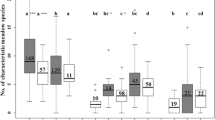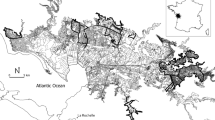Abstract
In this study we investigated the relationship between the distributionpatterns of a number of herbaceous plant species and the isolation and age ofhabitat patches. The study was conducted for a network of ditch banks in anagricultural landscape in The Netherlands. Thirteen plant species were selectedrepresenting contrasting dispersal and seed bank characteristics. Isolation ofhabitat patches was determined by the distance to the nearest occupied patchandby the number of occupied patches in circles of increasing radius around thepatches. Age was the number of years since the creation of the ditches. In amultiple logistic regression model the separate effects of age of the habitatand the spatial variables were analyzed. A number of habitat variables wereusedto correct the effect of habitat quality. We concluded that distributionpatterns of plant species were mainly determined by habitat quality and thepresence of seed sources at short distances (< 25 m). Thisconclusion was independent of the dispersal characteristics of the species.Mostspecies had higher occupation frequencies in older than younger ditch banks.Only species with persistent seeds had comparable occupation probabilities inolder and younger habitat patches, indicating the importance of the soil seedbank as a source of colonization after large-scale disturbances. The effect ofage and management on the occupation probabilities of the species was oftendiminished in the regression model, probably due to correlation between somehabitat variables and the age of the patches.
Similar content being viewed by others
References
Bakker J.P. and Berendse F. 1999. Constraints in the restoration of ecological diversity in grassland and heathland communities. Trends in Ecology and Evolution 14: 63–68.
Bakker J.P., Poschlod P., Strykstra R.J., Bekker R.M. and Thompson K. 1996. Seed banks and seed dispersal: important topics in restoration ecology. Acta Botanica Neerlandica 45: 461–490.
Bruggink M. and Buitink G. 1995. Experiment randenbeheer. In: De Snoo G.R., Rotteveel A.J.W. and Heemsbergen H. (eds), Akkerranden in Nederland. Werkgroep Akkerranden, Wageningen/Leiden, pp. 133–142.
Bunce R.G.H. and Hallam C.J. 1993. The ecological significance of linear features in agricultural landscapes in Britain. In: Bunce R.G.H., Ryszkowski L. and Paoletti M.G. (eds), Landscape Ecology and Agroecosystems. Lewis Publishers, Boca Raton, pp. 11–19.
Bunce R.G.H., Ryszkowski L. and Paoletti M.G. (eds) 1993. Landscape Ecology and Agroecosystems. Lewis Publishers, Boca Raton.
Cain M.L., Milligan B.G. and Strand A.E. 2000. Long-distance seed dispersal in plant populations. American Journal of Botany 87: 1217–1227.
CBS (Centraal Bureau voor de Statistiek) 1993. Botanisch Basis Register. CBS (Centraal Bureau voor de Statistiek), Voorburg.
Coulson S.J., Bullock J.M., Stevenson M.J. and Pywell R.F. 2001. Colonization of grassland by sown species: dispersal versus microsite limitation in responses to management. Journal of Applied Ecology 38: 204–216.
De Snoo G.R. and Van der Poll R.J. 1999. Effect of herbicide drift on adjacent boundary vegetation. Agriculture, Ecosystems and Environment 73: 1–6.
Eriksson O. 1996. Regional dynamics of plants: a review of evidence for remnant, source-sink and metapopulations. OIKOS 77: 248–258.
Eriksson O. 1997. Colonization dynamics and relative abundance of three plant species (Antennaria dioica, Hieracium polosella and Hypochoeris maculata) in dry semi-natural grasslands. Ecography 20: 559–568.
ESRI 2000. ArcView GIS 3.2a. Environmental Systems Research Institute Inc., Redlands, USA.
Fry G.L.A. 1994. The role of field margins in the landscape. In: Boatman N. (ed.), Field Margins: Integrating Agriculture and Conservation. British Crop Protection Council, Surrey, pp. 31–40.
Grashof-Bokdam C.J. and Geertsema W. 1998. The effect of isolation and history on colonization patterns of plant species in secondary woodland. Journal of Biogeography 25: 837–846.
Hanski I. 1985. Single-species dynamics may contribute to long-term rarity and commonness. Ecology 66: 335–343.
Hodgson J.G., Grime J.P., Hunt R. and Thompson K. 1995. The Electronic Comparative Plant Ecology. Chapman & Hall, London.
Husband B.C. and Barrett S.C.H. 1996. A metapopulation perspective in plant population biology. Journal of Ecology 84: 461–467.
Hutchings M.J. and Booth K.D. 1996. Studies on the feasibility of re-creating chalk grassland vegetation on ex-arable land. I. The potential roles of the seed bank and seed rain. Journal of Applied Ecology 33: 1171–1181.
Keen A. and Engel B. 1998. Procedure IRREML. In: Goedhart P.W. and Thissen J.T.N.M. (eds), CBW Genstat Procedure Library Manual Release 4.1. Centre for Biometry Wageningen, Wageningen, The Netherlands.
Kleijn D., Joenje W. and Kropff J.M. 1997. Patterns in species composition of arable field boundary vegetation. Acta Botanica Neerlandica 46: 175–192.
Kleijn D. and Verbeek M. 2000. Factors affecting the species composition of arable field boundary vegetation. Journal of Applied Ecology 37: 256–266.
Kleyer M. 1999. Distribution of plant functional types along gradients of disturbance intensity and resource supply in an agricultural landscape. Journal of Vegetation Science 19: 697–708.
Le Coeur D., Baudry J. and Burel F. 1997. Field margins plant assemblages: variation partitioning between local and landscape factors. Landscape and Urban Planning 37: 57–71.
Levins R. 1970. Extinctions. Some mathematical questions in biology. In: Gerstenhaber R. (ed.), Lectures on Mathematics in Life Sciences 2. The American Mathematical Society, Providence, RI, pp. 77–107.
Marshall E.J.P. and Arnold G.M. 1995. Factors affecting field weed and field margin flora on a farm in Essex, UK. Landscape and Urban Planning 31: 205–216.
Merriam G. 1988. Landscape dynamics in farmland. Trends in Ecology and Evolution 3: 16–20.
Nathan R. and Muller-Landau H.C. 2000. Spatial patterns of seed dispersal, their determinants and consequences for recruitment. Trends in Ecology and Evolution 15: 278–285.
Nip-Van der Voort J., Hengeveld R. and Haeck J. 1979. Immigration rates of plant species in three Dutch polders. Journal of Biogeography 6: 301–308.
Olff H. and Bakker J.P. 1991. Long-term dynamics of standing crop and species composition after the cessation of fertilizer application to mown grassland. Journal of Applied Ecology 28: 1040–1052.
Opdam P. 1990. Dispersal in fragmented populations: the key to survival. In: Bunce R.G.H. and Howard D.C. (eds), Species Dispersal in Agricultural Habitats. Belhaven Press, London, New York, pp. 3–17.
Pakeman R.J., Attwood J.P. and Engelen J. 1998. Sources of plants colonizing experimentally disturbed patches in an acidic grassland, in eastern England. Journal of Ecology 86: 1032–1041.
Parr T.W. and Way J.M. 1988. Management of roadside vegetation: the long-term effects of cutting. Journal of Applied Ecology 25: 1073–1087.
Perry N.H., Chaney K., Wilcox A. and Boatman N.D. 1996. The effect of fertiliser and herbicide application on herbaceous field margin communities. In: Marshall E.J.P., Morgan J.L. and Willoughby L. (eds), Vegetation Management in Forestry, Amenity and Conservation Areas: Managing for Multiple Objectives, Aspects of Applied Biology 4., pp. 339–344.
Primack R.B. and Miao S.L. 1992. Dispersal can limit local plant distribution. Conservation Biology 6: 513–519.
Schaminée J.H.J., Stortelder A.H.F. and Weeda E.J. 1996. De Vegetatie van Nederland 3. Opulus Press, Uppsala.
Schaminée J.H.J., Weeda E.J. and Westhoff V. 1998. De Vegetatie van Nederland 4. Opulus Press, Uppsala.
Schippers P. 2000. Dynamics of plant communities in field boundaries, restoration of biodiversity. PhD Dissertation,Wageningen University.
Smeding F.W. and Joenje W. 1999. Farm-Nature Plan: landscape ecology based farm planning. Landscape and Urban Planning 46: 109–115.
Stortelder A.F.H., Schaminée J.H.J. and Hommel P.W.F.M. 1999. De vegetatie van Nederland 5. Opulus Press, Uppsala.
Strykstra R.J., Bekker R.M. and Verweij G.L. 1996. Establishment of Rhinanthus angusitfolius in a successional hayfield after seed dispersal by mowing machinery. Acta Botanica Neerlandica 45: 557–562.
Tilman D. 1997. Community invasibility, recruitment limitation and grassland biodiversity. Ecology 78: 81–92.
Thompson K., Bakker J.P. and Bekker R.M. 1997. Soil Seed Banks of NW Europe: Methodology, Density and Longevity. Cambridge University Press, Cambridge.
Van der Meijden R. 1996. Heukels' Flora van Nederland. Wolters Noordhof, Groningen.
Van Dorp D. 1996. Seed dispersal in agricultural habitats and the restoration of species-rich meadows. PhD Dissertation, Agricultural University, Wageningen.
Van Dorp D., Van den Hoek W.P.M. and Daleboudt C. 1996. Seed dispersal capacity of six perennial grassland species measured in a windtunnel at varying wind speed and height. Canadian Journal of Botany 74: 1956–1963.
Van Groenendael J., Ehrlén J. and Svensson B.M. 2000. Dispersal and persistence: population processes and community dynamics. Folia Geobotanica 35: 107–114.
Van Strien A.J., Van der Linden J., Melman Th.C.P. and Noordervliet M.A.W. 1989. Factors affecting the vegetation of ditch banks in peat areas in the Western Netherlands. Journal of Applied Ecology 26: 989–1004.
Vos C.C. and Stumpel A.H.P. 1996. Comparison of habitat-isolation parameters in relation to fragmented distribution patterns in the tree frog (Hyla arborea). Landscape Ecology 11: 203–214.
Willson M.F. 1993. Dispersal mode, seed shadows and colonization patterns. Vegetatio 107/108: 261–280.
Wolf A., Brodmann P.A. and Harrison S. 1999. Distribution of the rare serpentine sunflower, Helianthus exilis (Asteraceae): the roles of habitat availability, dispersal limitation and species interactions. OIKOS 84: 69–76.
Author information
Authors and Affiliations
Rights and permissions
About this article
Cite this article
Geertsema, W., Sprangers, J. Plant distribution patterns related to species characteristics and spatial and temporal habitat heterogeneity in a network of ditch banks. Plant Ecology 162, 91–108 (2002). https://doi.org/10.1023/A:1020336908907
Issue Date:
DOI: https://doi.org/10.1023/A:1020336908907




